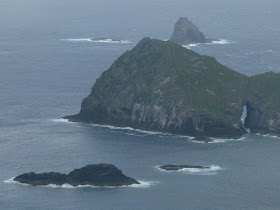As I have mentioned before,
Lord Howe Island is a very special place. One very memorable walk is along the tops of the Malabar Cliffs at the north end of the main island. It's a bit of a climb, but only to a little over 200 metres above sea level, starting at Ned's Beach. From up here though - initially on Malabar Hill, then along the cliffs themselves and finally on Kim's Lookout at the western end (underneath the 'b' of Malabar in the map below) - the views are superb, south right along the island and north to the offshore islets.
Here are a few of those views.
 |
| Ned's Beach from Malabar Hill; the route up gives grand views out to the sea to the east. |
 |
| Looking west along the cliffs. |
 |
| View south from Malabar Hill; the settlement is to the right, Mounts Lidgbird and Gower loom in the distance. |
 |
| Same view south, from Kim's Lookout, a couple of kilometres to the west. |
 |
| Admiralty Islands from the Malabar Cliffs, looking north. |
There is no doubt though that one of the highlights of the walk in summer is the floating parade of Red-tailed Tropicbirds Phaethon rubricauda that drift past, often displaying, sometimes in elegant courtship pairs. In these flights one bird drifts along while the other 'stands up' in the air, pushing so that it goes backwards, while both point their tails towards each other. At this time of year they nest on the cliff faces, in scrapes on the ground; here on Lord Howe is apparently the greatest breeding concentration in the world.
They range across the Pacific and Indian Oceans, but the places where we can enjoy them so readily from land are very limited.
 |
| Sadly I didn't manage to catch a photo of the pair display, though we watched them entranced for ages. |
These were the stars, but it would be unfair to ignore some of the other beautiful seabirds that soared along the cliffs.
 |
| Masked Booby Sula dactylatra; this is a big bird and their vertical plunges into the ocean from high up, chasing fish, are dramatic. |
 |
Sooty Tern, Onychoprion fuscatus;
they breed everywhere on the island in noisy restless colonies - the locals call them Wideawakes. |
There are many excellent reasons to spend a week on Lord Howe; the Malabar Cliffs is one good one.
 |
| Roach Island from Malabar Cliffs. |
BACK ON FRIDAY











No comments:
Post a Comment